belt TOYOTA SEQUOIA 2010 2.G Quick Reference Guide
[x] Cancel search | Manufacturer: TOYOTA, Model Year: 2010, Model line: SEQUOIA, Model: TOYOTA SEQUOIA 2010 2.GPages: 34, PDF Size: 2.1 MB
Page 2 of 34
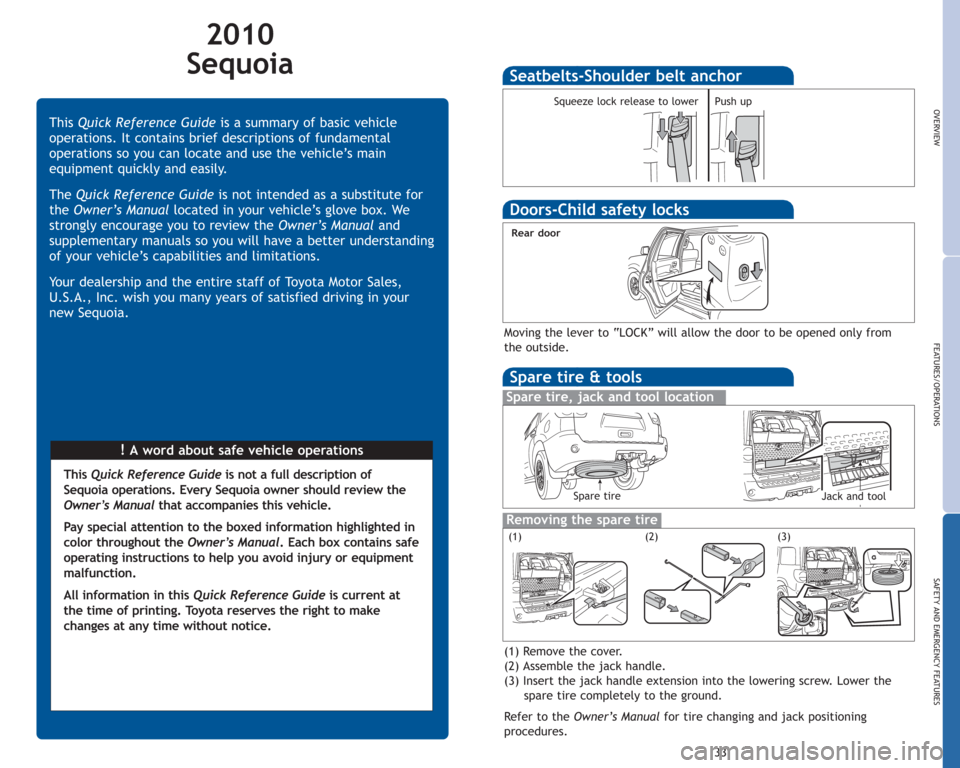
2010
Sequoia
!A word about safe vehicle operations This Quick Reference Guideis a summary of basic vehicle
operations. It contains brief descriptions of fundamental
operations so you can locate and use the vehicle’s main
equipment quickly and easily.
The Quick Reference Guideis not intended as a substitute for
theOwner’s Manual located in your vehicle’s glove box. We
strongly encourage you to review theOwner’s Manual and
supplementary manuals so you will have a better understanding
of your vehicle’s capabilities and limitations.
Your dealership and the entire staff of Toyota Motor Sales,
U.S.A., Inc. wish you many years of satisfied driving in your
new Sequoia.
This Quick Reference Guideis not a full description of
Sequoia operations. Every Sequoia owner should review the
Owner’s Manualthat accompanies this vehicle.
Pay special attention to the boxed information highlighted in
color throughout the Owner’s Manual. Each box contains safe
operating instructions to help you avoid injury or equipment
malfunction.
All information in this Quick Reference Guideis current at
the time of printing. Toyota reserves the right to make
changes at any time without notice.
33
OVERVIEW
FEATURES/OPERATIONS
SAFETY AND EMERGENCY FEATURES
Push up
Seatbelts-Shoulder belt anchor
Squeeze lock release to lower
Spare tire & tools
Spare tire, jack and tool location
Removing the spare tire
(1) Remove the cover.
(2) Assemble the jack handle.
(3) Insert the jack handle extension into the lowering screw. Lower the
spare tire completely to the ground.
Refer to the Owner’s Manualfor tire changing and jack positioning
procedures.
Moving the lever to “LOCK” will allow the door to be opened only from
the outside.
Rear door
Doors-Child safety locks
(1)(2)(3)
Spare tireJack and tool
Page 3 of 34
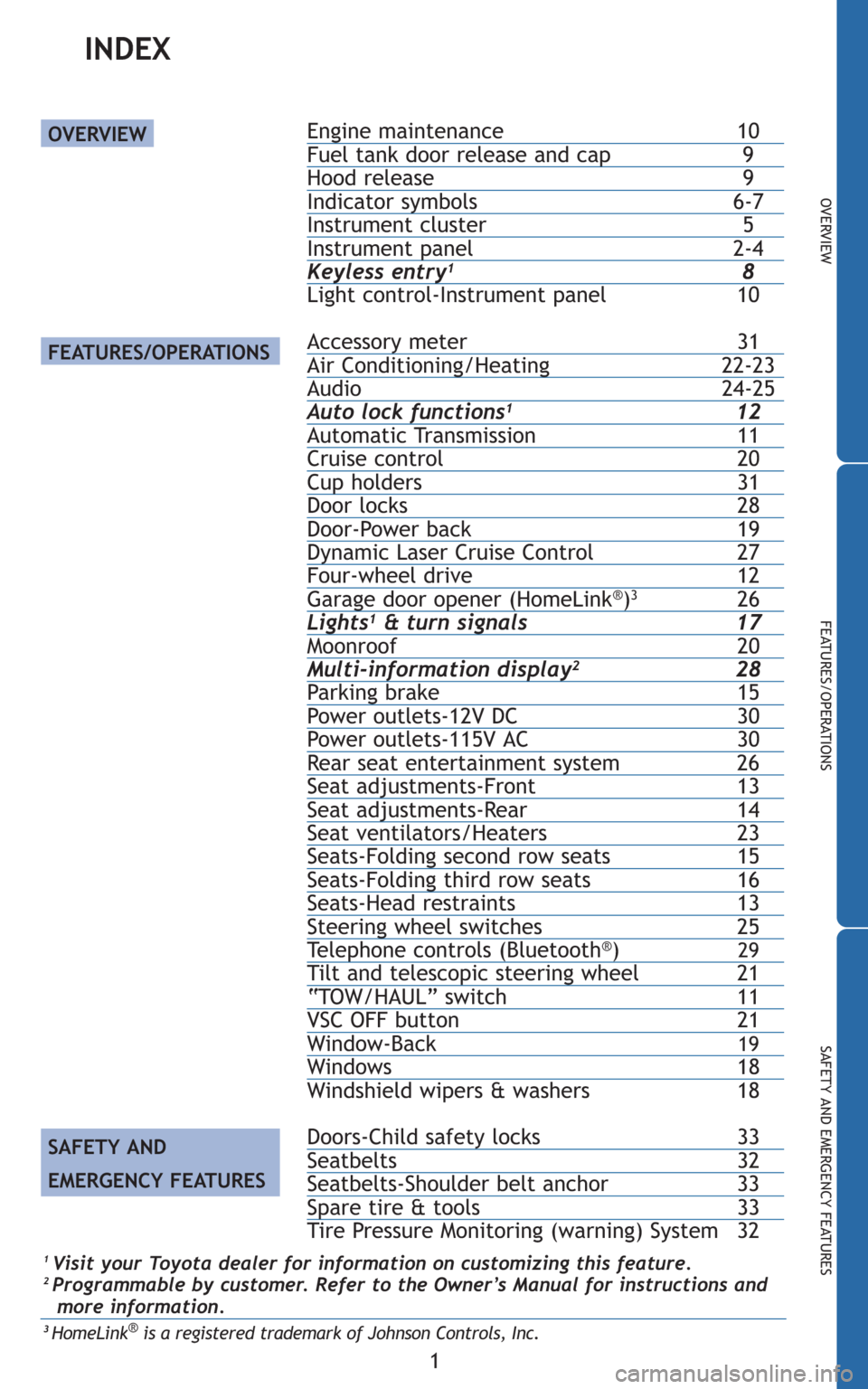
1
OVERVIEW
FEATURES/OPERATIONS
SAFETY AND EMERGENCY FEATURES
Engine maintenance 10Fuel tank door release and cap 9Hood release 9Indicator symbols 6-7Instrument cluster 5Instrument panel 2-4Keyless entry18
Light control-Instrument panel 10
Accessory meter 31Air Conditioning/Heating 22-23Audio 24-25Auto lock functions112Automatic Transmission 11Cruise control 20Cup holders 31Door locks 28Door-Power back 19Dynamic Laser Cruise Control 27Four-wheel drive 12Garage door opener (HomeLink®)326Lights1& turn signals 17Moonroof 20Multi-information display228Parking brake 15Power outlets-12V DC 30Power outlets-115V AC 30Rear seat entertainment system 26Seat adjustments-Front 13Seat adjustments-Rear 14Seat ventilators/Heaters 23Seats-Folding second row seats 15Seats-Folding third row seats 16Seats-Head restraints 13Steering wheel switches 25Telephone controls (Bluetooth®)29Tilt and telescopic steering wheel 21“TOW/HAUL” switch 11VSC OFF button 21Window-Back19Windows 18
Windshield wipers & washers 18
Doors-Child safety locks 33Seatbelts 32Seatbelts-Shoulder belt anchor 33Spare tire & tools 33
Tire Pressure Monitoring (warning) System 32
OVERVIEW
FEATURES/OPERATIONS
SAFETY AND
EMERGENCY FEATURES
1Visit your Toyota dealer for information on customizing this feature.2 Programmable by customer. Refer to the Owner’s Manual for instructions and
more information.
3HomeLink®is a registered trademark of Johnson Controls, Inc.
INDEX
Page 8 of 34
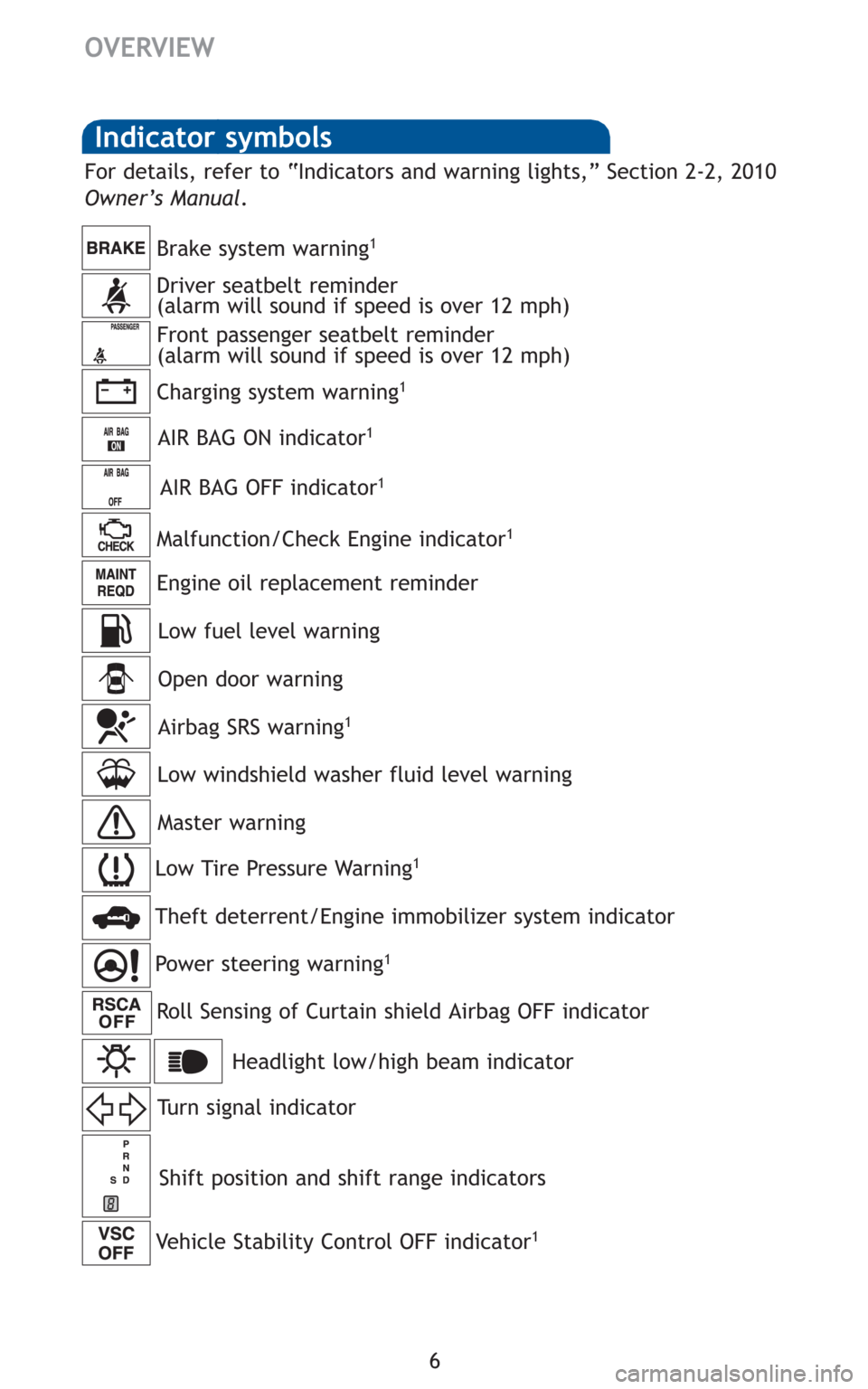
6
Indicator symbols
Charging system warning1
Brake system warning1
AIR BAG ON indicator1
Driver seatbelt reminder
(alarm will sound if speed is over 12 mph)
Front passenger seatbelt reminder
(alarm will sound if speed is over 12 mph)
AIR BAG OFF indicator1
For details, refer to “Indicators and warning lights,” Section 2-2, 2010
Owner’s Manual.
Headlight low/high beam indicator
Turn signal indicator
Low Tire Pressure Warning1
Power steering warning1
Open door warning
Airbag SRS warning1
Master warning
Theft deterrent/Engine immobilizer system indicatorMalfunction/Check Engine indicator
1
Engine oil replacement reminder
Low fuel level warning
Roll Sensing of Curtain shield Airbag OFF indicator
Shift position and shift range indicators
Vehicle Stability Control OFF indicator1
Low windshield washer fluid level warning
OVERVIEW
Page 17 of 34
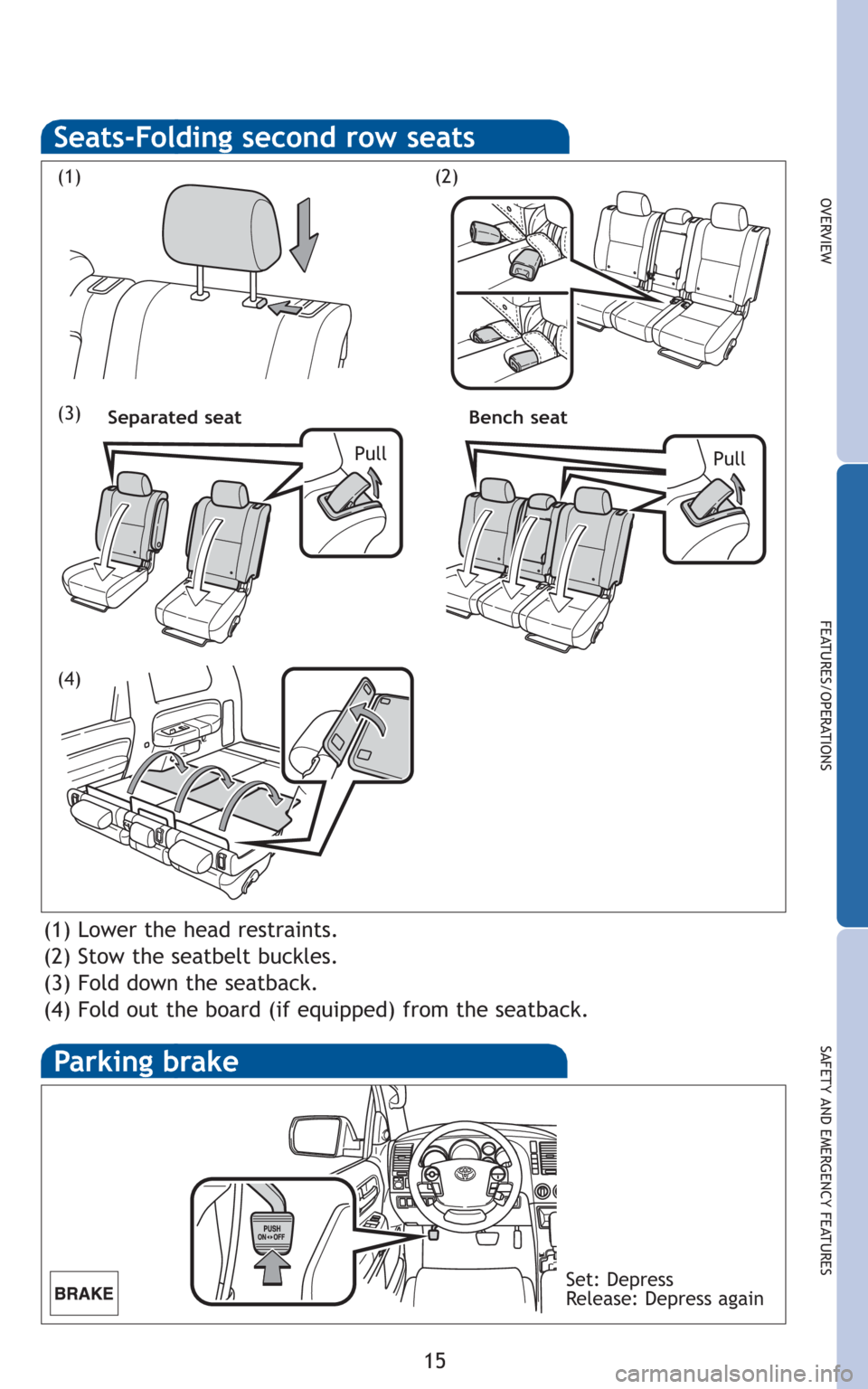
15
OVERVIEW
FEATURES/OPERATIONS
SAFETY AND EMERGENCY FEATURES
(1) Lower the head restraints.
(2) Stow the seatbelt buckles.
(3) Fold down the seatback.
(4) Fold out the board (if equipped) from the seatback.
(1)
(3)
(2)
Seats-Folding second row seats
(4)Pull
Pull
Separated seat Bench seat
Parking brake
Set: Depress
Release: Depress again
Page 18 of 34
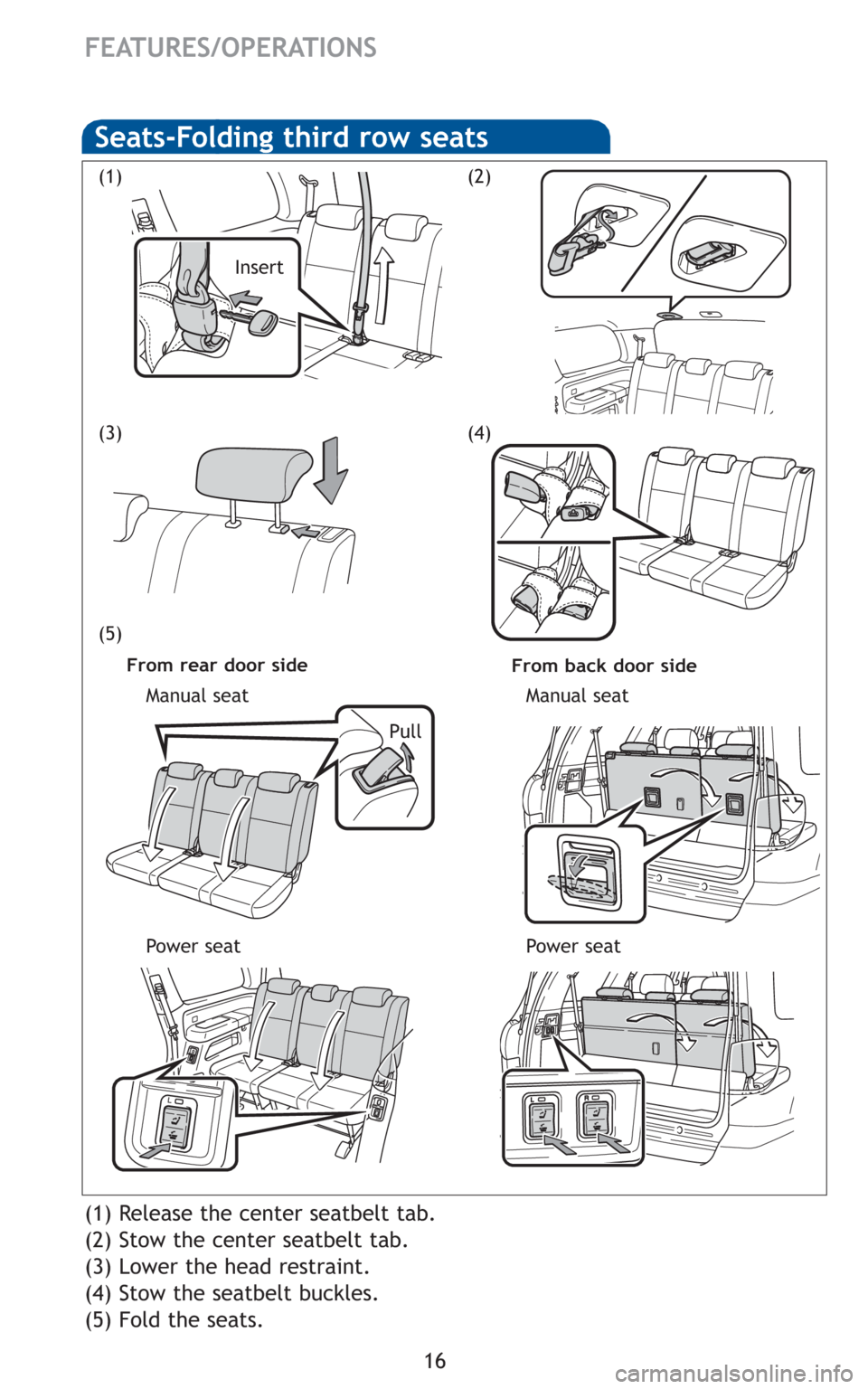
16
FEATURES/OPERATIONS
(1) Release the center seatbelt tab.
(2) Stow the center seatbelt tab.
(3) Lower the head restraint.
(4) Stow the seatbelt buckles.
(5) Fold the seats.
(1)
(5)
(3)
(2)
Seats-Folding third row seats
(4)
Power seatPull Insert
From back door side From rear door side
Power seat
Manual seatManual seat
Page 34 of 34
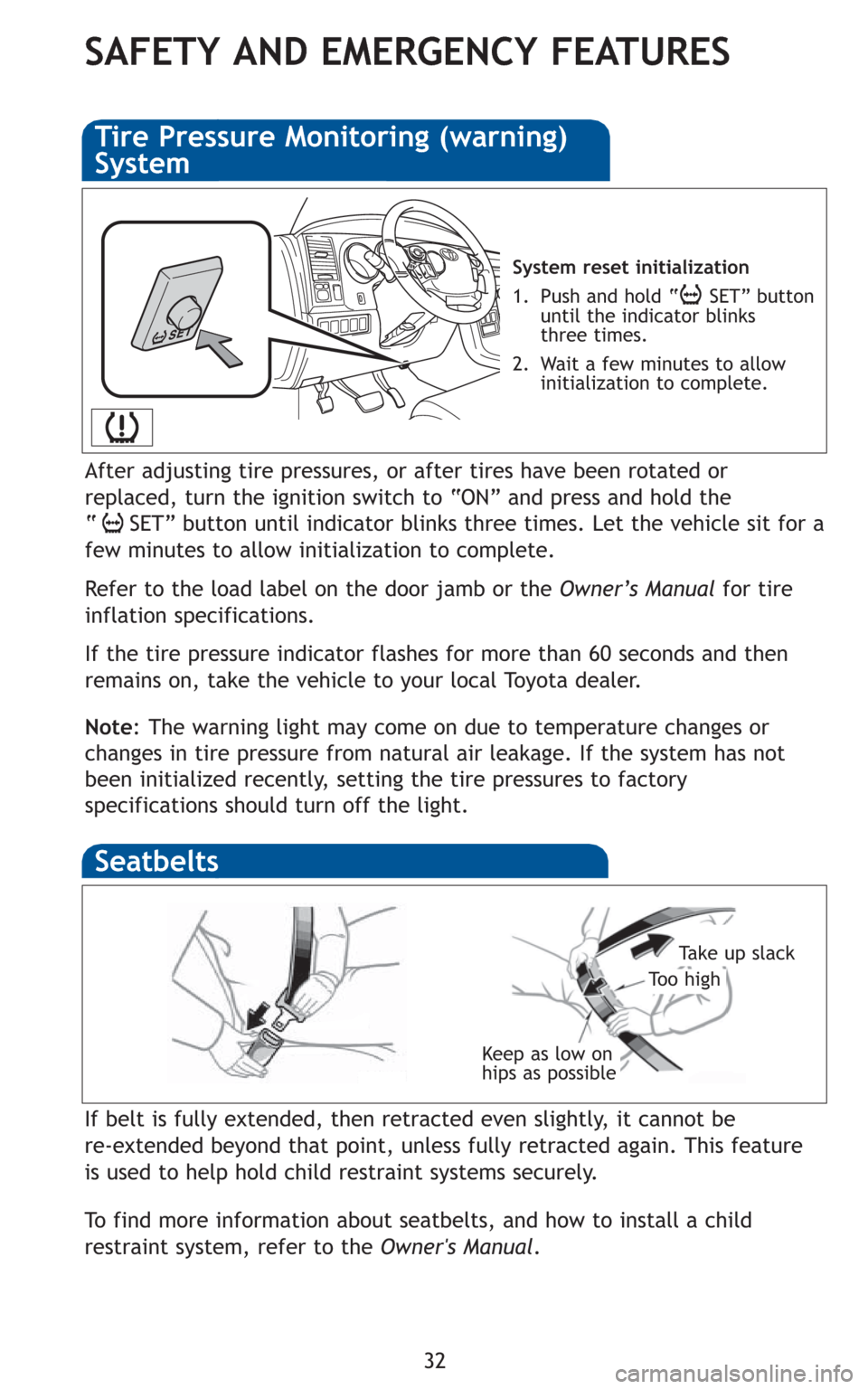
32
SAFETY AND EMERGENCY FEATURES
If belt is fully extended, then retracted even slightly, it cannot be
re-extended beyond that point, unless fully retracted again. This feature
is used to help hold child restraint systems securely.
To find more information about seatbelts, and how to install a child
restraint system, refer to the Owner's Manual.
Keep as low on
hips as possible
Take up slack
Too high
Seatbelts
System reset initialization
1. Push and hold “ SET” button
until the indicator blinks
three times.
2. Wait a few minutes to allow
initialization to complete.
Tire Pressure Monitoring (warning)
System
After adjusting tire pressures, or after tires have been rotated or
replaced, turn the ignition switch to “ON” and press and hold the
“ SET” button until indicator blinks three times. Let the vehicle sit for a
few minutes to allow initialization to complete.
Refer to the load label on the door jamb or the Owner’s Manualfor tire
inflation specifications.
If the tire pressure indicator flashes for more than 60 seconds and then
remains on, take the vehicle to your local Toyota dealer.
Note: The warning light may come on due to temperature changes or
changes in tire pressure from natural air leakage. If the system has not
been initialized recently, setting the tire pressures to factory
specifications should turn off the light.